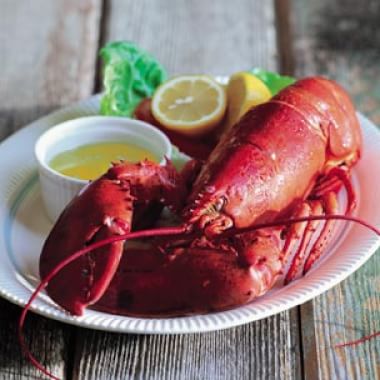All About Lobster

On a candlelit table or in a clambake on the beach, a bright orange lobster is one of the undisputed icons of special occasions. Although once so plentiful that American colonists dismissed it as food for the poor, lobster now demands royal treatment in upscale restaurants and commands equally majestic prices.
Lobsters can be divided into two broad categories: clawed lobsters and spiny lobsters. Clawed lobsters are what come to mind when most of us think "lobster." This includes orange and black American lobsters, also called Maine lobsters, which live in the cold waters off Newfoundland and New England. (Orange lobsters are blue-black when uncooked, turning orange when cooked.) They appear at market from July through November. Although similar to the American lobster, blue-black European lobsters are now scarce and extremely expensive. Some believe European lobsters have more delicate flavor and texture, but others can detect no significant difference.
Spiny lobsters, also known as rock lobsters or langoustes, lack large claws but are easily recognized by their extra-long antennae and the thin spines covering their hard shell. Cold-water spiny lobsters found near South Africa and Australia boast better-quality meat than the warm-water species from Florida and the Caribbean. California spiny lobsters are rarely found beyond the markets of southern California and western Mexico. Actually sea-dwelling crayfish, live spiny lobsters arrive at local markets only from August to March. Their tails, however, with flesh slightly tougher and not as sweet as that of the American lobster, are widely available frozen.
Although New England purists insist that only drawn butter and corn should appear next to lobster on the dinner table, the sweet, rich flavor of this popular crustacean pairs well with a wide range of flavors, from dill, tarragon, basil, parsley and saffron to mustard, lemongrass and lime. Avocado, cucumber, citrus fruits, white wine, brandy, cream, coconut milk, chilies and eggs are just a handful of the ingredients that are often matched with lobster.
Selecting
When buying a live lobster, choose one that proves especially feisty. Hold a lobster up, grasping its sides safely behind its claws, to check that it quickly snaps its tail tightly under its body. Any that are sluggish and apathetic have been in the tank too long. Captured lobsters are not fed, so their meat will shrink away with time. Likewise, when purchasing a whole cooked lobster, make sure that its tail curls, an indication that it was still alive when it was dropped into the cooking pot.
A lively debate rages between those who prefer the firmer flesh of male clawed lobsters and those who like the sweet flesh of females. Also hotly contested are the merits of succulent 1-pound "chicken" lobsters versus fleshy 3-pound "jumbos." Those who have braved 10-pounders swear that the giants are just as sweet and tender. Most lobsters sold at markets fall between 1 1/4 and 2 pounds.
He or She?
Although missing one or both claws, less expensive "culls" taste just as good in soups, stews and salads. If you lack a reliable local source for live lobsters, numerous companies can ship them to you overnight. Frozen lobster tails, usually from spiny lobsters, and already-cooked whole lobsters can give you a head start on recipes.
Storing
If not cooking live lobsters immediately, cover them with a damp cloth or wet newspaper, place them in a small cardboard box or large, heavy paper bag and refrigerate. Although best if prepared as soon as possible after purchase, you can keep them in the refrigerator for up to 2 days, if needed. Expect the quality of the meat to diminish significantly with each day. Leave the rubber bands on in order to prevent mishaps with snapping claws. Do not immerse lobsters in tap water, for they will quickly die. Uncooked tails can be kept in the freezer in a zippered plastic freezer bag for 3 to 4 months, but cooked lobster will turn mushy and flavorless if frozen.
Adapted from Williams-Sonoma Kitchen Companion: The A to Z Guide to Everyday Cooking, Equipment and Ingredients (Time-Life Books, 2000)